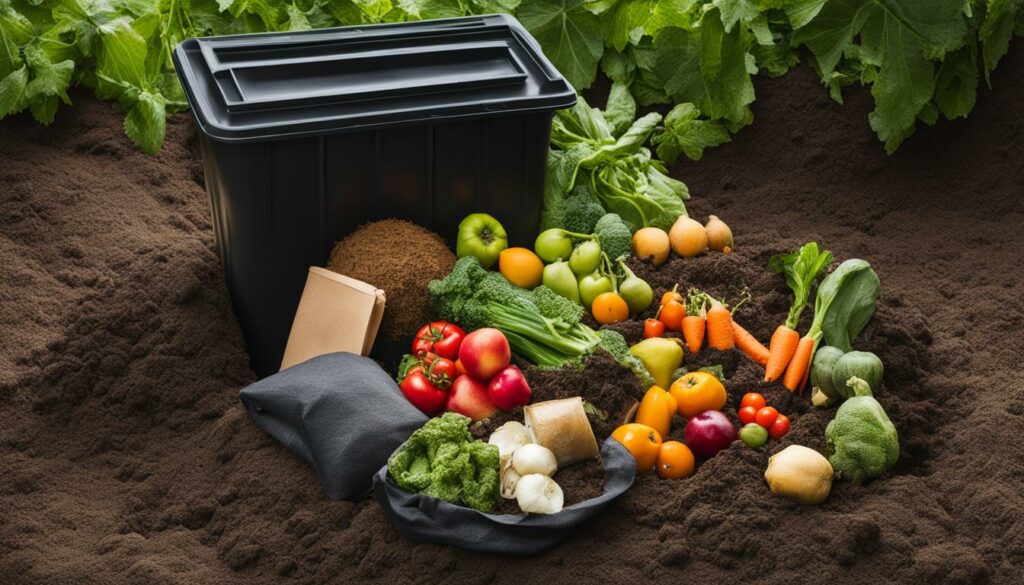Living a sustainable lifestyle doesn’t have to be complicated or expensive. There are many simple and practical ways to incorporate sustainability into your everyday life. By making small changes to reduce waste, conserve energy and water, support local businesses, and make eco-conscious choices, you can have a positive impact on the environment and promote a greener future.
Key Takeaways:
- Reducing waste and opting for reusable products can significantly contribute to sustainability.
- Minimizing plastic use helps combat plastic pollution and its adverse effects on the environment.
- Conserving energy and water is crucial for sustainable living.
- Supporting local and sustainable food choices promotes a greener future.
- Choosing sustainable transportation options reduces carbon emissions.
Reduce Waste and Opt for Reusable Products
In today’s world, where environmental concerns are increasingly pressing, reducing waste and opting for reusable products is a simple yet impactful way to embrace a sustainable lifestyle. By making conscious choices and adopting eco-friendly habits, we can contribute to the preservation of our planet for future generations. Let’s explore some practical tips to help reduce waste and incorporate reusable products into our daily lives.
Eco-conscious Shopping Habits
One of the easiest ways to reduce waste is by changing our shopping habits. Instead of relying on single-use plastic bags, invest in reusable shopping bags made of sturdy materials like cotton or jute. These bags can be used repeatedly and are not only environmentally friendly but also more durable. Additionally, consider using reusable produce bags when purchasing fruits and vegetables. These mesh or cloth bags can replace the disposable plastic ones and help reduce plastic waste.
“Carry a reusable water bottle and coffee mug with you to avoid using disposable cups and bottles.”
The Rise of Sustainable Fashion
In recent years, the concept of sustainable fashion has gained significant traction. By supporting sustainable fashion brands or opting for secondhand clothing, we can reduce the environmental impact of the fashion industry. Fast fashion has long been associated with excess waste and unethical practices. But by embracing sustainable fashion, we can promote zero waste and ethical production. Consider exploring thrift stores, consignment shops, or online platforms for unique, pre-loved pieces that are not only stylish but also sustainable.
| Benefits of Sustainable Fashion | Costs of Fast Fashion |
|---|---|
| Reduces waste | Creates excessive waste |
| Supports ethical production | Exploits workers in low-income countries |
| Promotes circular economy | Contributes to environmental degradation |
The Power of Composting
Composting is another effective way to reduce waste and promote sustainable living. Instead of sending organic waste to landfills, we can transform it into nutrient-rich soil that can be used for gardening or landscaping. Composting not only reduces methane emissions from decomposing waste but also enriches soil health and reduces the need for synthetic fertilizers. Whether you live in a house with a backyard or an apartment with limited space, there are various composting methods available to suit your lifestyle and circumstances.

By embracing the practice of reducing waste and incorporating reusable products into our everyday lives, we can make a significant positive impact on the environment. From using reusable shopping bags to supporting sustainable fashion and practicing composting, every small action counts. Let’s take responsibility for our consumption habits and work towards a more sustainable future for ourselves and generations to come.
Minimize Plastic Use
Plastic pollution is a pressing environmental issue that requires immediate attention. By minimizing plastic use in our daily lives, we can significantly reduce the amount of plastic waste that ends up in landfills and our oceans. Ditching single-use plastics, opting for sustainable packaging, and making eco-conscious choices can make a real difference.
Single-Use Plastics: A Detrimental Impact
Single-use plastics, such as water bottles, bags, and straws, contribute to the growing plastic waste problem. These items are used once and then discarded, taking hundreds of years to decompose. By refusing single-use plastics and adopting reusable alternatives, like stainless steel water bottles and cloth bags, we can help break the cycle of plastic consumption.
Sustainable Packaging: Making a Difference
Choosing products packaged in sustainable materials is another way to minimize plastic use. Opt for glass, metal, or paper packaging whenever possible. These materials are more eco-friendly, as they can be recycled or biodegraded. Additionally, consider supporting brands that prioritize sustainable packaging practices, such as refillable or compostable options.
“Plastic waste is a global crisis that demands action from individuals, businesses, and governments alike.” – Environmental activist
| Plastic Bags | Reusable Bags | Savings | |
|---|---|---|---|
| Energy Consumption | 15 MJ | 0.005 MJ | 99.97% |
| Water Consumption | 22 liters | 0.005 liters | 99.98% |
| CO2 Emissions | 10 kg | 0.003 kg | 99.97% |
Note: The table above illustrates the significant reduction in energy consumption, water consumption, and CO2 emissions when switching from plastic bags to reusable bags.
By minimizing plastic use and opting for sustainable alternatives, we can play an active role in combating plastic waste and safeguarding our planet for future generations.

Conserve Energy and Water
Conserving energy and water is essential for sustainable living. By making conscious choices and adopting energy-efficient practices, you can reduce your environmental footprint and contribute to a greener future.
One of the most effective ways to conserve energy is by turning off lights and electronic devices when they are not in use. This simple habit can significantly reduce energy consumption. Additionally, consider using energy-efficient lighting options such as LED bulbs, which consume less electricity and have a longer lifespan.
Energy-Efficient Appliances
Investing in energy-efficient appliances is another great way to conserve energy. Look for appliances with the Energy Star label, as they meet strict energy efficiency standards set by the U.S. Environmental Protection Agency. These appliances use less energy and can help you save money on your utility bills.
When it comes to water conservation, there are several actions you can take to minimize water waste. Start by fixing any leaky faucets or pipes in your home. A small drip may seem insignificant, but it can waste a significant amount of water over time.
Water-Saving Habits
Develop water-saving habits, such as taking shorter showers and turning off the tap while brushing your teeth or washing dishes. Installing low-flow fixtures, such as showerheads and faucets, can further reduce water usage without sacrificing performance.
In addition to these measures, consider utilizing renewable energy sources to power your home. Solar panels are a popular choice for homeowners looking to reduce their reliance on fossil fuels and lower their energy bills. By harnessing the power of the sun, you can generate clean and renewable energy to meet your household’s needs.
By adopting energy and water conservation practices and making use of renewable energy sources, you can play a significant role in protecting the environment and promoting sustainable living.
Support Local and Sustainable Food Choices
When it comes to living a sustainable lifestyle, making conscious choices about the food we consume plays a vital role. Supporting local produce and sustainable agriculture not only benefits the environment but also contributes to healthier communities. By adopting a plant-based diet, reducing food waste, and choosing organic farming practices, we can make a positive impact on our planet.
Eating Local and Seasonal
One way to support local and sustainable food choices is by shopping for locally grown produce. Farmers’ markets are an excellent place to find a variety of fresh and seasonal fruits, vegetables, and other locally sourced products. By buying locally, we reduce the carbon footprint associated with transportation and support local farmers and businesses.
Embracing a Plant-Based Diet
Another way to promote sustainable food choices is by adopting a plant-based diet or reducing our meat consumption. Animal agriculture is a significant contributor to greenhouse gas emissions and deforestation. By incorporating more plant-based meals into our diet, we can help reduce the environmental impact of the food industry and improve our own health.
Reducing Food Waste and Supporting Organic Farming
Food waste is a significant issue globally. By planning our meals, freezing leftovers, and composting food scraps, we can minimize waste and contribute to sustainable food practices. Additionally, supporting organic farming practices helps protect soil health, biodiversity, and reduces the use of harmful pesticides and fertilizers.
| Benefits of Supporting Local and Sustainable Food Choices |
|---|
| Reduces carbon footprint associated with transportation |
| Supports local farmers and businesses |
| Minimizes environmental impact of animal agriculture |
| Improves personal health with a plant-based diet |
| Reduces food waste and promotes sustainable practices |
| Protects soil health and biodiversity through organic farming |
Supporting local and sustainable food choices is not only beneficial for the environment but also essential for creating a healthier and more resilient food system. By making these small changes in our everyday lives, we can contribute to a more sustainable future for generations to come.

Opt for Sustainable Transportation
When it comes to sustainable living, transportation plays a significant role in reducing our carbon footprint. By choosing green commuting options, we can contribute to a greener and more environmentally friendly future. Here are some ways to incorporate sustainable transportation into your lifestyle:
Public Transportation
One of the easiest and most accessible ways to reduce your environmental impact is by utilizing public transportation. Instead of driving solo in a car, consider taking the bus, train, or subway. Not only does public transportation help decrease traffic congestion, but it also reduces air pollution and saves energy. Plus, you can use your commute time to relax, read a book, or catch up on work.
Electric Vehicles
Another great option for sustainable transportation is investing in an electric vehicle (EV). Electric vehicles produce zero tailpipe emissions, meaning they don’t contribute to air pollution. With advancements in technology, EVs have become more affordable and accessible than ever before. Charging your EV with renewable energy sources further enhances its eco-friendly benefits. By transitioning to electric vehicles, we can significantly reduce our reliance on fossil fuels and make a positive impact on the environment.
Biking and Walking
If your destination is nearby, consider biking or walking instead of driving. Not only is biking and walking good for the environment, but it also promotes personal health and well-being. These active modes of transportation not only reduce greenhouse gas emissions but also help improve air quality in urban areas. Additionally, biking and walking can save you money on fuel and parking costs while providing an opportunity to stay active and enjoy the outdoors.
| Mode of Transportation | Environmental Impact | Benefits |
|---|---|---|
| Public Transportation | Reduces air pollution and energy consumption | Cost-effective, reduces traffic congestion |
| Electric Vehicles | Zero tailpipe emissions, reduces reliance on fossil fuels | Lower maintenance costs, potential for renewable energy charging |
| Biking and Walking | Zero emissions, improves air quality in urban areas | Cost-effective, promotes personal health and fitness |
By embracing sustainable transportation options such as public transportation, electric vehicles, biking, and walking, we can reduce our carbon footprint and promote a cleaner, healthier planet for future generations. Each individual choice towards sustainable transport contributes to a larger collective effort in creating a more sustainable future.
Embrace Green Home Practices
Creating a sustainable and environmentally friendly home is a crucial step towards a greener future. By adopting green home practices, you can minimize your carbon footprint, conserve resources, and contribute to a healthier planet.
Use Sustainable Materials
When constructing or renovating your home, opt for sustainable materials that have a lower impact on the environment. Consider using bamboo flooring, which is a renewable resource that grows quickly and requires fewer chemicals compared to traditional hardwood flooring. Reclaimed wood is another eco-friendly choice that reduces deforestation and gives a unique character to your home.
Install Energy-Efficient Lighting
Switching to energy-efficient lighting options can significantly reduce your energy consumption. Choose LED bulbs, which are more efficient and have a longer lifespan compared to traditional incandescent bulbs. LED lights also produce less heat, making them safer and more environmentally friendly. Additionally, install dimmer switches in rooms to further conserve energy by adjusting the brightness according to your needs.
Embrace Green Building
Implementing green building practices can make your home more energy-efficient and sustainable. Proper insulation plays a key role in reducing energy loss and maintaining a comfortable indoor temperature. Invest in insulation materials with high R-values to prevent air leakage and reduce heating and cooling costs. Consider incorporating passive solar design elements, such as large south-facing windows, to maximize natural light and heat during winter months. By utilizing green building techniques, you can create a home that is both eco-friendly and energy-efficient.
Embracing green home practices not only benefits the environment but also enhances the comfort and health of your living space. By using sustainable materials, installing energy-efficient lighting, and implementing green building techniques, you can create a home that aligns with your values and promotes a greener future.
Educate Yourself and Take Action
To make a real impact on the environment and promote sustainability, it’s important to educate yourself and take action. Environmental education is the foundation for creating sustainable communities and driving climate action. By staying informed and learning about the latest sustainable practices, you can better understand the challenges we face and find solutions to address them.
One way to start is by researching and reading credible sources on environmental issues. Stay updated on scientific research, policy developments, and successful conservation efforts. Seek out organizations and websites dedicated to sustainability and environmental education. Engaging with informative content can expand your knowledge and empower you to make informed decisions.
In addition to self-education, taking action is crucial. Get involved in local conservation efforts or join community initiatives that promote sustainable living. Volunteering your time can make a tangible difference in addressing environmental challenges. You can participate in activities such as tree planting, beach cleanups, or educational campaigns. By joining forces with others who share the same goals, you can amplify your impact and create a sense of collective responsibility.
Advocacy and policy engagement are also important in driving change. Support policies that protect the environment and advocate for climate action. Reach out to your local representatives and express your concerns about environmental issues. By raising awareness, participating in public discussions, and supporting grassroots movements, you can contribute to a more sustainable future for all.
Remember, every individual action counts. By educating yourself and taking action, you can inspire others and create a ripple effect of positive change. Together, we can build sustainable communities, protect our planet, and ensure a healthier future for generations to come.
Conclusion
By integrating sustainable living habits into your everyday life, you can make a positive impact on the environment. Embrace eco-friendly choices, practice responsible consumption, and raise awareness about the importance of sustainability.
From reducing waste to conserving resources, supporting local businesses, and making conscious choices, each action adds up to a more sustainable future for all. By adopting sustainable living habits, you can contribute to a healthier planet and inspire others to do the same.
Remember, sustainable living is about more than just individual actions; it’s about creating a collective shift towards environmental awareness and responsible consumption. By making small changes in our daily lives, we can create a ripple effect that extends beyond ourselves and creates a greener and more environmentally conscious world for future generations.
How Can Sustainable Living Practices Contribute to Mental Health and Well-Being?
Incorporating sustainable living practices into daily life can promote mental health and well-being. Embracing activities like gardening, walking, and mindfulness can reduce stress and anxiety. Additionally, engaging in a digital detox for mental health allows for more meaningful connections and improved overall mental clarity.
Source Links
- https://www.biologicaldiversity.org/programs/population_and_sustainability/sustainability/live_more_sustainably.html
- https://thefoxandshe.com/ways-to-be-sustainable-in-everyday-life/
- https://moveforhunger.org/blog/easy-ways-be-more-sustainable-2023

